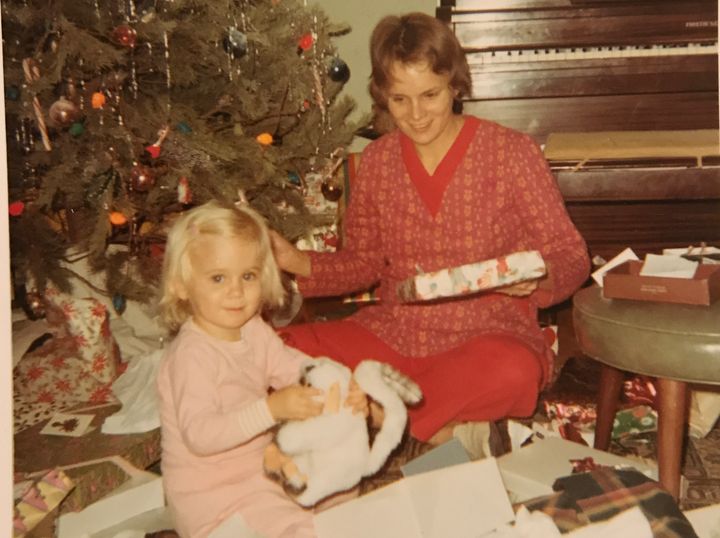by Marcia Walker, SAS Product Marketing Manager (and sepsis survivor)

My mother and me (1972)
I have only recently come to appreciate the beauty and value of death. My mother died quite young, when I was still a teenager and she was in her early forties. I could not process her loss at the time – I had neither the intellectual nor the emotional skills to face such grief at such a young age. I will always remember the poignancy of one small thing, a tiny yet powerful detail she shared during her short illness; a cancer she knew she would not survive.
She told us she had no regrets, none at all; she would not have done anything differently.
But she would miss riding rollercoasters. She would miss the joy of rollercoasters, and was sad that she would never again ride another one.
For years afterward I would not ride a rollercoaster myself, refusing to indulge in something that my mother could no longer do. How could I live fully, laugh and scream and feel free, when she was gone? Completely and utterly gone.
Gradually I gained the intellectual, emotional and spiritual insights to process what had happened; to see that the end which had come for her would eventually come for us all. And gradually, oh-so-very-gradually, I came to recognize that death is in fact a gift. It is a gift that forces us to appreciate life. Without it, we would simply take our miracle of living for granted.
And slowly I began to realize that the way through grief is not hard work, and certainly not self-deprivation. The way through grief is joy.
For this reason, I marked my fortieth birthday by celebrating life. I took my closest friends to Orlando, Florida and we rode every rollercoaster that Universal Studios had to offer. I screamed with delight as “The Hulk” hurtled me over a precipice, then dropped me, pressed my eyes shut in exhilarating terror as other coasters took me on loop-de-loops, and laughed as my friends got drenched in water plumes on other rides. I enjoyed every moment of every experience I had deprived myself of for so long. And I thanked my mom. I thanked her for teaching me to live fully while the living was good.
And to see death for the teacher that it is.
But I am in no hurry. I see death as a transition, an inevitable transition, and one that I am in absolutely no hurry to make. So when, in 2010, I recognized that I had symptoms of sepsis after a minor and apparently insignificant infection in my elbow, I sought immediate medical care. By the time I reached the urgent care facility, my blood pressure was crashing. They started intravenous fluids and called an ambulance; within an hour I was in the emergency room at the local hospital, where powerful antibiotics were added to the treatment regimen. This quick action did save my life, but it was a close call. When I was still very ill days later, and doctors were warning me I might not survive, I called my father to say my goodbyes. I told him that if I didn’t make it that he shouldn’t be sad. That I was not sad. That I was grateful, and lucky, for the time that I had been given, and I wanted to thank him for his part in that.
After six days in the hospital, weeks of in-home care with ongoing IV antibiotics, and almost a year of rehabilitation for my damaged arm, my life returned to almost-normal.
Almost-normal is exponentially better than normal. Almost-normal is life with an awareness of death. Life where with every footstep you can say, and feel, and truly appreciate in your bones, “This is amazing! I am experiencing gravity! Gravity is a miracle, and I am experiencing it right now.”
Almost-normal is when you can sit in a conference room with your colleagues, and instead of thinking “When will this meeting ever end?”, you think “How lucky I am to interact with these astonishingly intelligent and creative and beautiful people. Each one of them is a miracle, here for only a moment, and I have the privilege to share this with them. Every one of them is smarter than I will ever be, and I get to learn from these miracles, to see life through their eyes, to know things only they can teach me.”
And you mean it.
Almost-normal is when you go home at the end of a long day, and you look at your cat and you think, “What a delight it is that I share a world with such a furry little creature. She has fur coming out of her ears. And I get to snuggle her every single day and hear her purr and she is a miracle.”
And then you sit on the couch with your incredible husband and watch funny movies, and you see the “Bring Out Your Dead” scene in Monty Python and the Holy Grail, and the man in the scene refuses to get on the body cart and insists, “I’m not dead yet!”
And you laugh and laugh, tears rolling down your cheeks, and you feel the joy fill your entire being. And you know, and accept, that it is only temporary. You’re not dead yet, but you will be soon enough. We all will be, but not yet, and we all have so much more that we can enjoy in the meantime.
Not dead yet.
And you go to work the next day and you volunteer your time to a project called GatherIQ, a project to raise awareness of sepsis, because you know that almost half of the population has never heard of this deadly condition, even though it is the leading cause of death after heart disease and cancer. You know that for every hour that goes by without treatment, the chances of survival go down by 8%. You know that if you yourself had not been aware of sepsis, that you would not have gotten to the hospital quickly enough back in 2010, and you would have no more rollercoasters to ride. No more gravity to experience. No more colleagues to appreciate. No more cats to snuggle. And no more belly laughs to enjoy.
Almost-normal means writing a blog with a not-so-normal title, “Not Dead Yet”, and telling your own story, and feeling vulnerable and exposed, and yet committed. Committed to sharing what happened to you and what you are doing through GatherIQ, so that others will have more rollercoasters to ride.
Because one million people per year get sepsis in the United States alone – and between 28% and 50% of them will die from it.
But they do not have to.
They are not dead yet.
With greater awareness of sepsis and what to do about it, many of them would not die from it. And that is what the Sepsis Alliance is working to accomplish. We can all contribute to that effort by downloading the app and helping them answer some seemingly simple questions that can help to bring about powerful change. The answers you discover will help the Sepsis Alliance target its future awareness efforts to help ensure everyone gets to the hospital on time:
- At what education level are people least likely to correctly identify sepsis symptoms?
- What age group is least likely to know about sepsis?
- What race/ethnic backgrounds are least likely to know about sepsis?
- Is there a significant difference between parents (and of how many children) and adults with no children in terms of who knows about sepsis?
Once you help answer these questions, by exploring the data available in the app, please weigh in on the community forums within the app itself and share your findings to your social networks using the hashtags #GatherIQ and #SepsisHero. Your contribution will be recognized at the annual Sepsis Heroes award dinner in New York City. You might also be invited to participate in a panel at the 2018 SAS Global Forum event in Denver, Colorado to help demonstrate the power of crowdsourcing analytics with “citizen data scientists”.
Please do everything you can to help the Sepsis Alliance target their educational efforts so more people like me will recognize the symptoms of sepsis and get timely medical care. Download the app here.
